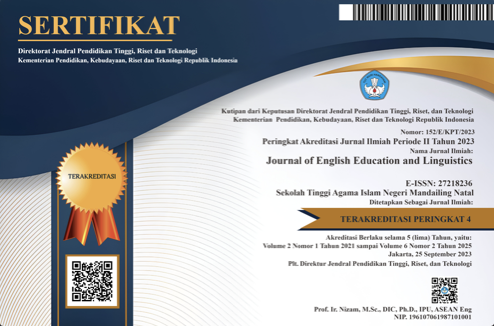THE ATTITUDE OF ROHINGYA TEENAGERS TOWARDS THEIR LANGUAGE
DOI:
https://doi.org/10.56874/jeel.v1i2.243Keywords:
Language attitude, Rohingya teenagers, descriptive qualitativeAbstract
This study deals with language attitude of Rohingya teenagers toward their ethnic language in Medan. A qualitative descriptive research design was applied. The aim of the study is to know the attitudes of Rohingya teenagers towards their ethnic language. The subject of this research are eighteen of the Rohingya teenagers at the age 15-21 years old. The instruments used for this study were observation and interview. The data was analyzed by using interactive models of Miles & Huberman (1984) technique. Based on the data analysis, it was found that Rohingya teenagers realized their language attitude in three ways, i.e: they use Rohingya language at home, they use Rohingya language at religion domain and they use Rohingya language in friendship domain. It was also found that the attitudes of the Rohingya teenagers caused by some reason, i.e: because they are loyal and maintain the Rohingya language, because they are proud and make the Rohingya language as their identity, and because they have awareness of language norms towards Rohingya language.
References
Baker, C. 1992. Attitudes and Language. Clavedon: Multilingual Matters Ltd.
Bogman, R. C. & Biklen, S.K. 1992. Qualitative Research for Education: In Introduction to
Theory and Methods. Needham Height: Allyn and Bacon.
Chalak, A., & Kassaian, Z. (2010). Motivation and Attitudes of Iranian Undergraduate EFL
Students towards Learning English. GEMA Online Journal of Language Studies.
Crystal, D. 2000. Language Death. Cambridge: Cambridge University Press.
Dorian, Nancy C. 1981. Language Death: The life Cycle of a Scottish Dialect. University of
Pensylvania Press, Philadelpia.
Edwards, J. 1985. Language, society, and identity. Oxford: Basil Blackwell (in association with André Deutsch).
Ferguson, C.A. 1968. Language development. In J.A. Fishman, C.A. Ferguson and J. Das Gupta (eds). Problems of Developing Nations: New York Milley.
Fishman, J. A. 1972. Language in Sociocultural Change. Stanford: Standford University Press.
Fishman, J. A. 2001. Can Threatened Languages Be Saved?. Clevedon: Multilingual Matters. Garret, P. 2010. Attitudes to Language. Cambridge University Press.
Garvin, P.L., & Mathiot, M. 1968. The Urbanization of Guarani Language: Problem in Language and Culture. In Fishman, J. A. (Ed) Reading in Test Sociology of Language. Mounton: Paris-The Hague.
Holmes, J. 2001. An introduction to Sociolinguistics (2nd ed). Edinburgh Gate: Pearson Education Unlimited.
Sneddon, J. 2003. The Indonesian Language: Its History and Role in Modern Society. Sydney: UNSW Press Ltd.
Starks, D., & Paltridge, B. 1996. A note on using sociolinguistics methods to study non-native attitudes towards English (7th ed). World-Englishes.
Tanner, J M. 1967. Book Review: Child Health and Development.
Downloads
Published
Issue
Section
License
All articles published in the Journal of English Education and Linguistics are licensed under a Creative Commons Attribution-ShareAlike 4.0 International (CC BY-SA) license. This means anyone is free to copy, transform, or redistribute articles for any lawful purpose in any medium, provided they give appropriate attribution to the original author(s) and Journal of English Education and Linguistics, link to the license, indicate if changes were made, and redistribute any derivative work under the same license.
Copyright on articles is retained by the respective author(s) without restrictions. A non-exclusive license is granted to the Journal of English Education and Linguistics to publish the article and identify itself as its original publisher, along with the commercial right to include the article in a hardcopy issue for sale to libraries and individuals.
Although the conditions of the Creative Commons Attribution-ShareAlike 4.0 International (CC BY-SA) license do not apply to authors (as the copyright holder of your article, you have no restrictions on your rights), by submitting to the Journal of English Education and Linguistics, authors recognize the rights of readers and must grant any third party the right to use their articles to the extent provided by the license.

This work is licensed under a Creative Commons Attribution-ShareAlike 4.0 International License.








